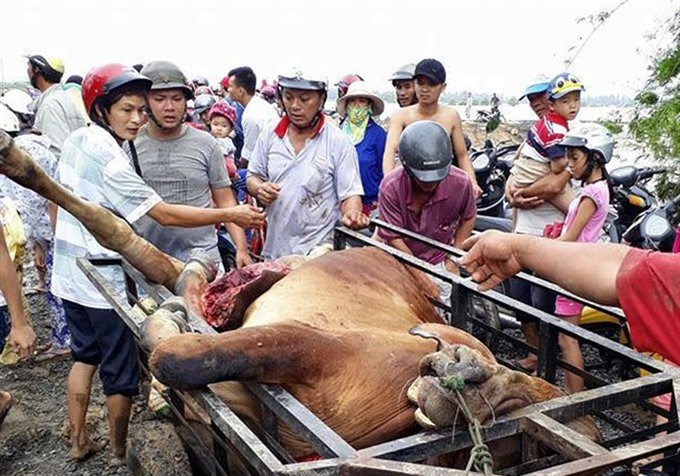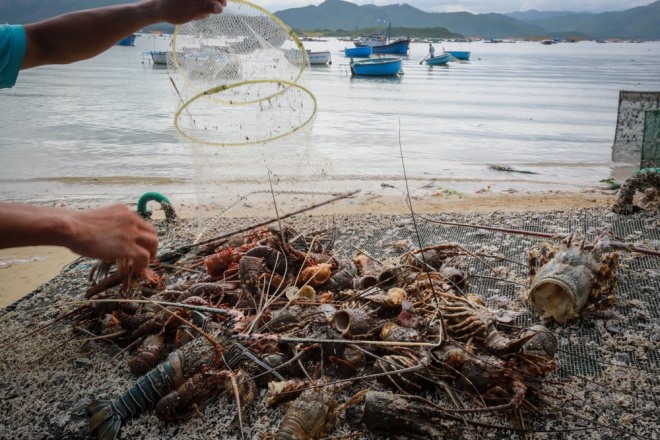 Environment
Environment

Up to 15 people were killed and another six are missing from heavy downpours and flooding in the central region and Central Highlands.
 |
| A cow dies in flooding in Hoa An Commune, Phu Hoa District, Phu Yen Province. Recent severe flooding in the central region and Central Highlands killed 15 people and left another six missing. — VNA/VNS PhotoPhan Sáu |
HÀ NỘI – Up to 15 people were killed and another six are missing from heavy downpours and flooding in the central region and Central Highlands.
The figures were updated yesterday by the Central Steering Committee for Disaster Prevention and the National Committee for Search and Rescue, compiled from damage reports of 13 localities affected in the prolonged downpour.
Flooding affected ten provinces: Hà Tĩnh, Quảng Bình, Quảng Trị, Thừa Thiên-Huế, Quảng Ngãi, Bình Định, Phú Yên, Khánh Hòa, Ninh Thuận and Bình Thuận. Another three in the Central Highlands including Kon Tum, Gia Lai and Đắk Lắk were also on the map of disaster-hit localities.
The current death toll rose from 10 announced in Saturday’s report. Phú Yên province suffered the heaviest loss, with a total of seven killed and one missing. Quảng Bình had three deaths while Quảng Trị and Bình Định each lost two residents. The last victim was from Đắk Lắk Province.
Heavy rain started last Monday and continued throughout the week, flooding nearly 41,000 houses across the two regions, of which 223 houses were damaged by 50 to 70 per cent, according to yesterday’s report of the Department of Disaster Prevention in the Central region and Central Highlands (DDPCCH).
The agriculture sector was hit badly with about 12,000 hectares of paddy and vegetable fields under water, while some 42,724 poultry and another 440 cattle were drowned or washed away.
The DDPCCH estimated the economic damages caused by the flooding at VNĐ492 billion (US$21.8 million) as of yesterday morning. Damage in Phú Yên alone amounts to about VNĐ337 billion, accounting for nearly 70 per cent of the total losses.
 |
| Lobsters dies en mass in Công Cầu Town, Phú Yên Province. — Photo vnexpress.net |
Phú Yên People’s Committee yesterday asked the Government to urgently send 1,100 tonnes of rice as aid relief for some 33,600 people affected by the flooding. Phú Yên and Đắk Lắk were the only two provinces with most of the land still under water as of yesterday.
Flood waters fully receded in Hà Tĩnh, Quảng Bình, Quảng Trị and Thừa Thiên-Huế, while low lands in the remaining provinces were still submerged.
The Central Steering Committee for Disaster Prevention warned the provinces to keep monitoring rain and flood forecasts, and be prepared to evacuate residents from areas prone to flash flooding and landslides.
Prolonged rains in Mekong Delta
Meanwhile thousands of hectares of the 2016-17 winter-spring rice season, which were sown early in the Cửu Long (Mekong) Delta, have been damaged by prolonged and heavy rains.
In Hậu Giang Province, many farmers have had to pump rain water out of paddy fields to save their young rice.
Nguyễn Văn Hơn in Hậu Giang’s Vị Thuỷ District said his family used more than 100 litters of diesel oil to pump water out of two hectares of 10 day old rice.
“But before all the redundant water had been pumped out of the field, rains continue occurring. As a result, about 30 per cent of the rice has died,” he said.
Rains have flooded more than 210ha of newly sown paddy fields in Hậu Giang, causing 10-50 per cent of newly sown rice in the fields to die, according to the provincial Department of Agriculture and Rural Development.
Under the province’s plan for the 2016-17 winter-spring rice crop, Hậu Giang planned to sow about 30,000ha in the crop’s first sowing stage in October.
But the province has sown about 4,000ha so far.
Lê Văn Đời, deputy director of the Hậu Giang Province Department of Agriculture and Rural Development, said the 30,000ha of rice are planned to be sown early in areas which are prone to irrigation water shortage near the end of the crop because of drought and salt water intrusion.
However, continuing rains made the process of sowing rice slower than scheduled, he said.
The Hậu Giang Province Department of Agriculture and Rural Development has warned farmers to temporarily stop sowing rice seeds as prolonged rains are forecast to continue in coming days.
Farmers can resume sowing rice seeds between November 15 and December 15, the main sowing period of the 2016-17 winter-spring rice crop, said the department.
In Long An Province, prolonged rains have caused damage to about 7,500ha of rice aged 5-20 days old.
Besides prolonged rains, the delta’s annual flooding is increasing in the Đồng Tháp Mười (Plain of Reeds) region, threatening the safety of rice areas which are not protected by dykes in Long An.
The annual flooding is caused by the rising levels of the Mekong River and its tributaries between August and November.
The Long An Province Department of Agriculture and Rural Development in co-operation with district authorities is consolidating dykes and pumping water out of paddy fields to mitigate the damage for farmers.
Đồng Tháp Province has also sown more than 60,000ha of the 2015-16 winter-spring crop and prolonged rains have affected many paddy fields in Hồng Ngự, Tân Hồng, Tam Nông and Tháp Mười districts.
In Tháp Mười alone, more than 250ha of winter-spring rice have been inundated. Of the figure, more than 150ha have been damaged 70-100 per cent.
Nguyễn Phú Bền in Tháp Mười, who has sown more than 7ha of glutinous rice, said prolonged and heavy rains caused the loss of sown seeds and increased extra production costs.
The extra production costs included buying pesticides to kill golden snails and hiring people to transplant new rice seedlings in areas where rice seedlings died because of flooding, he said.
Costs had increased by VNĐ2-4 million per hectare (US$90-180), he said.
Đồng Tháp authorities have mobilised more pumps to suction water out of paddy fields and warned farmers to sow rice seeds according to schedules to mitigate damage.
The delta, the country’s rice granary, plans to grow about 1.5 million hectares of rice in the 2016-17 winter-spring crop, down nearly 5,000ha compared to the 2015-16 winter-spring crop, according to the Ministry of Agriculture and Rural Development’s Plant Cultivation Department.
Under the Plant Cultivation Department’s sowing schedules for the delta, the region planned to sow early about 420,000 ha of winter-spring rice last month, continue sowing the rest of the areas in the following months and finish the sowing by January 10, 2017. – VNS




